The combination of microbiological, biochemical, and quality index methods in quality evaluation of pacific white shrimps (Litopenaeus vannamei) preserved at 0°C
In this study, the sensory, microbiological, and biochemical qualities were used to examine the quality of Pacific white shrimps (Litopenaeus vannamei) preserved at 0°C during a 10-Day period. The sensory quality was evaluated by a quality index (QI) that resulted from a quality index method (QIM) scheme. Meanwhile, the total viable count (TVC) and K-value were used to assess the microbiological and biochemical qualities of the shrimp. On day 9, the results from TVC and QIM have shown that the shrimp showed signs of spoilage, corresponding to a log CFU/g of 6.4 and a QI of 21.37, which is unacceptable to consumers. The QI increased linearly with storage days therefore the remaining shelf-life of the shrimp was estimated from a linear regression equation. In particular, this study found a linear relationship between QI, K-value, and hypoxanthine content. Furthermore, hypoxanthine itself could be considered as an independent quality index like the K-index. In conclusion, the quality of Pacific white shrimp was categorized into four different classes: excellent, good, acceptable, and moderately acceptable, based on its sensory and biochemical quality indicators
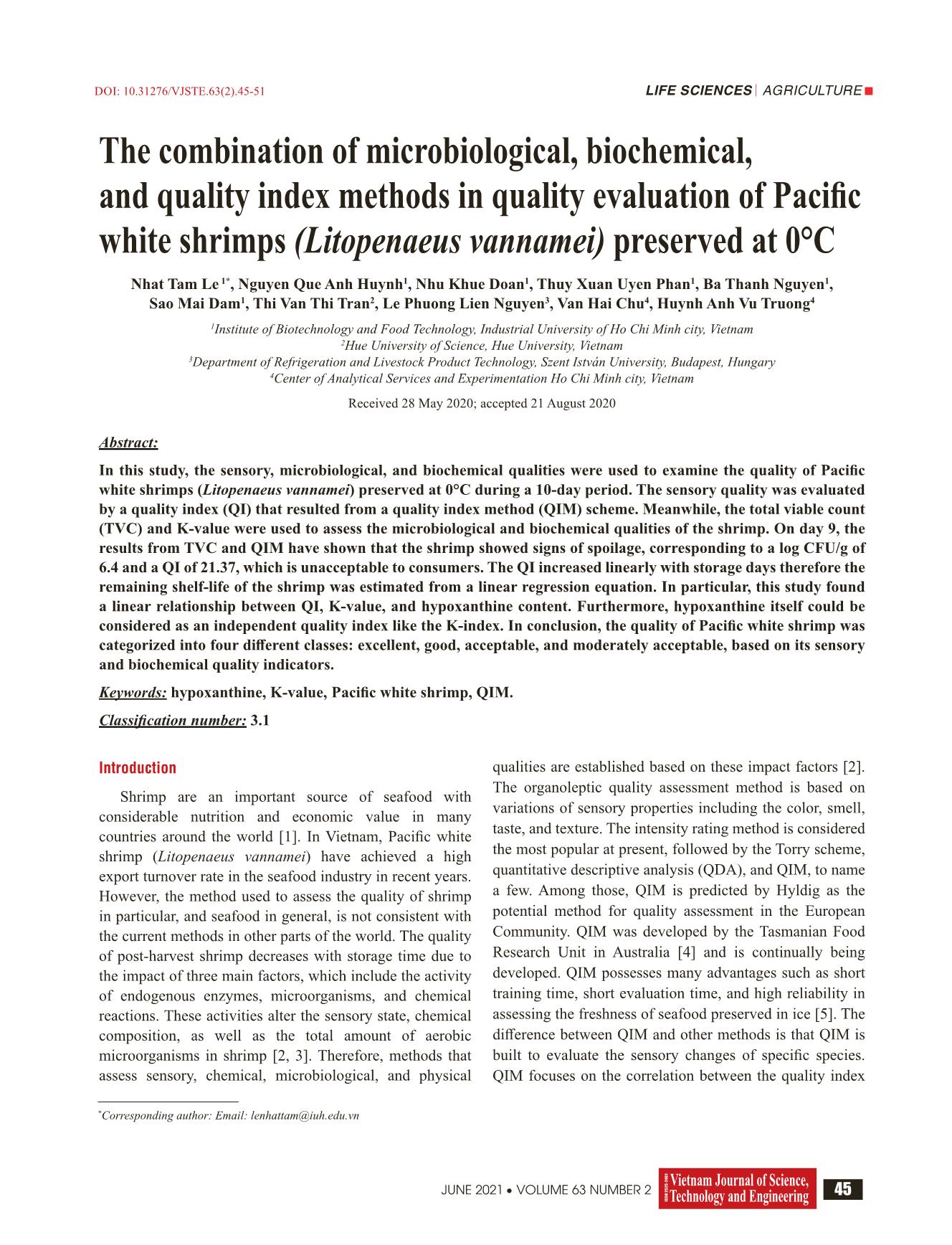
Trang 1
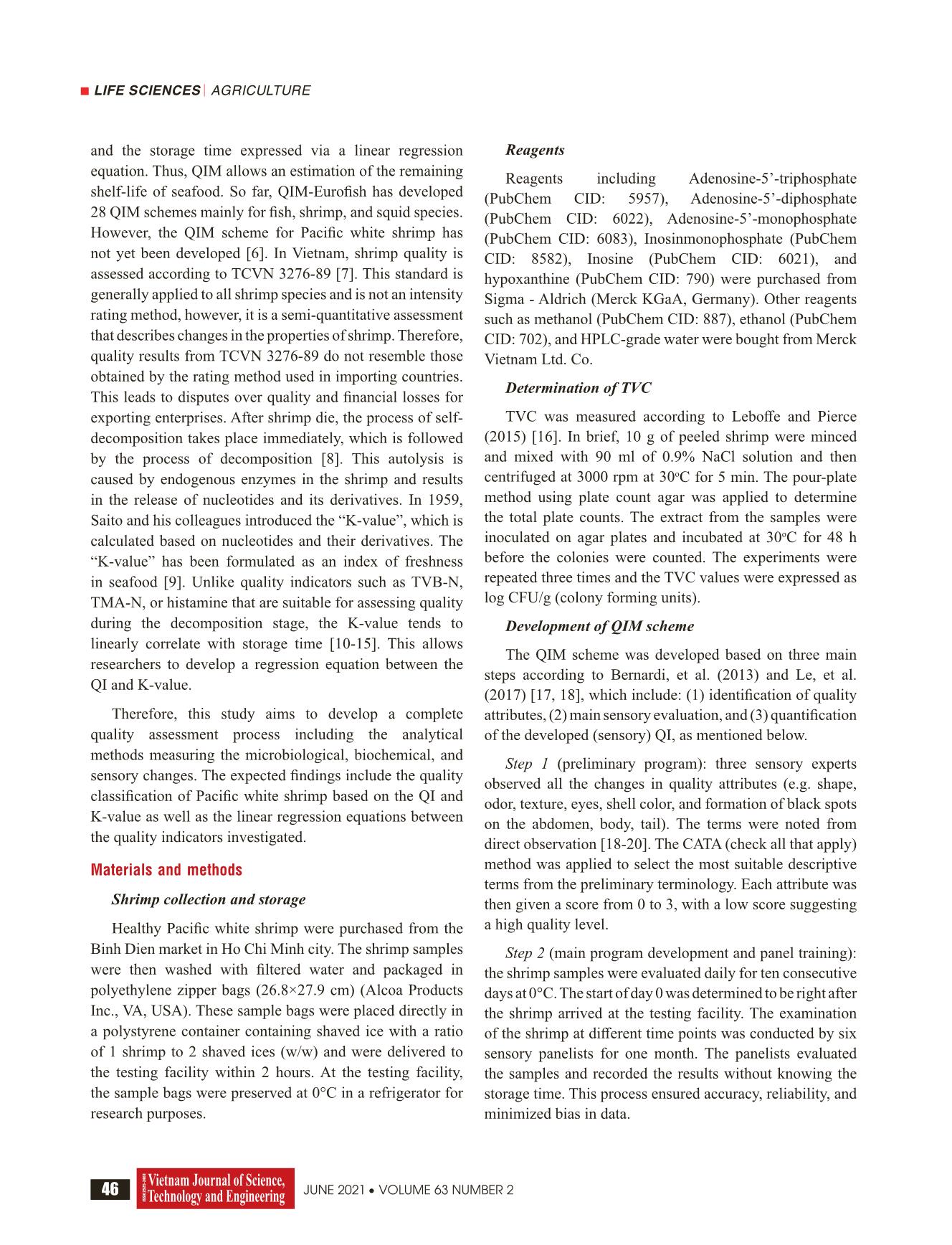
Trang 2
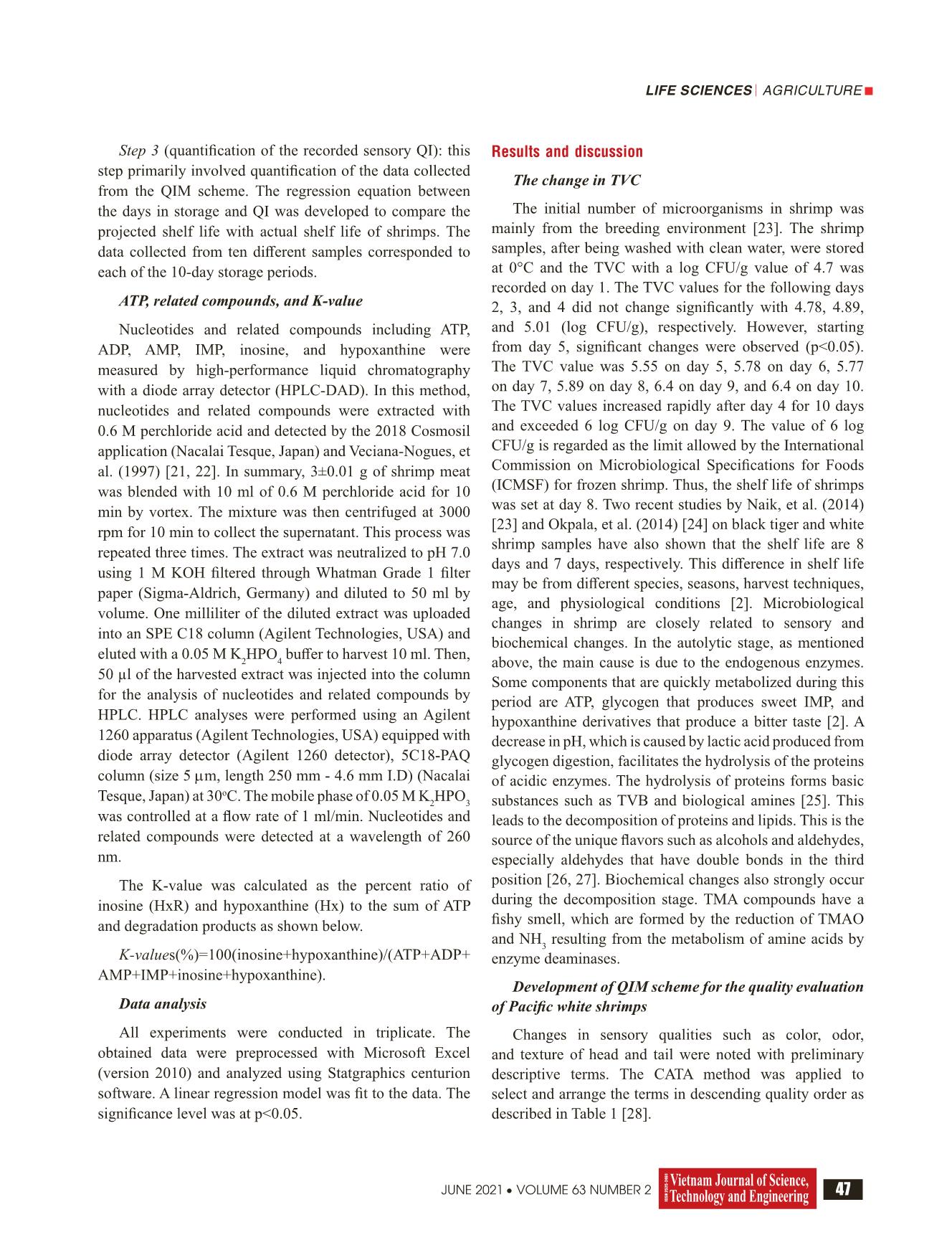
Trang 3

Trang 4
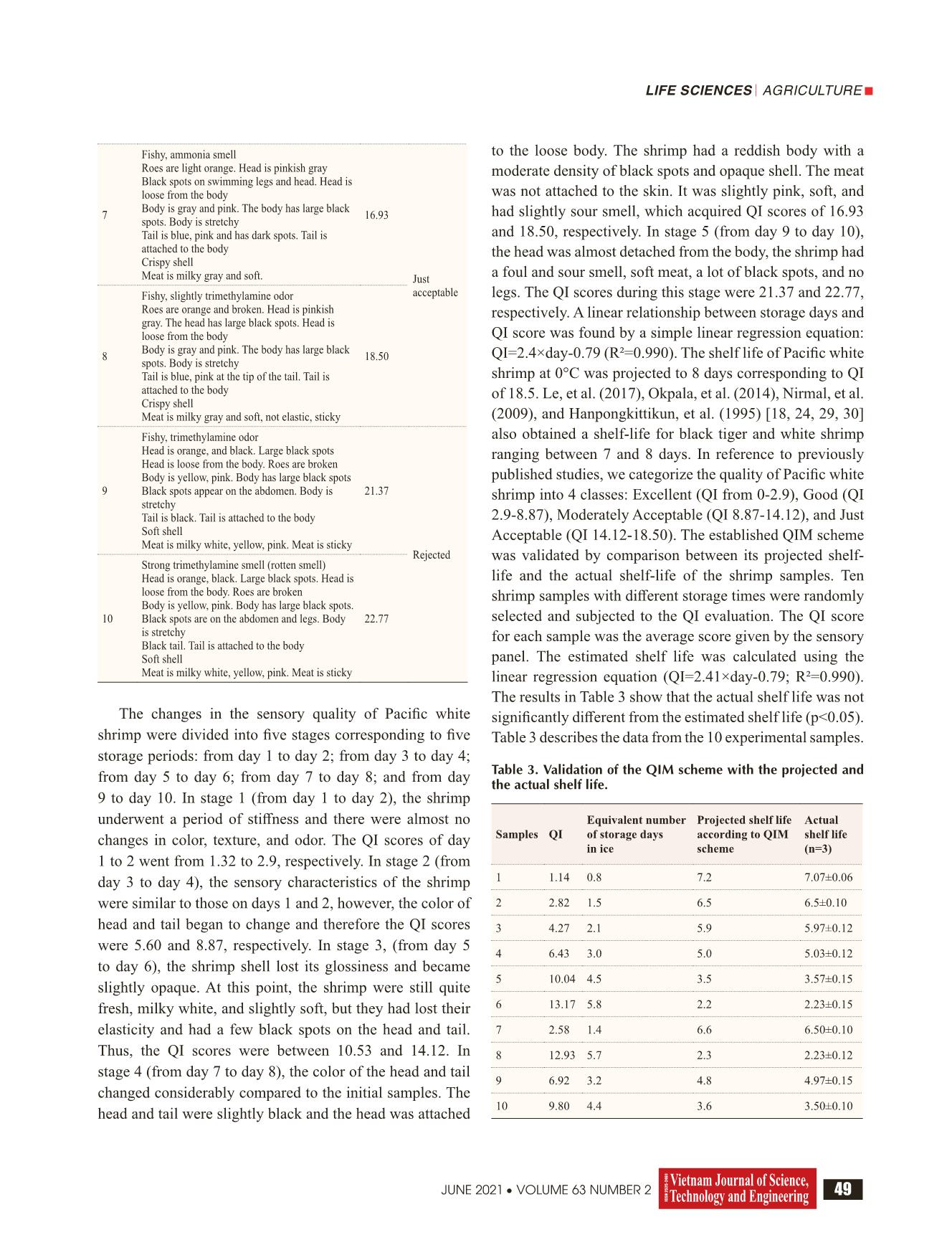
Trang 5
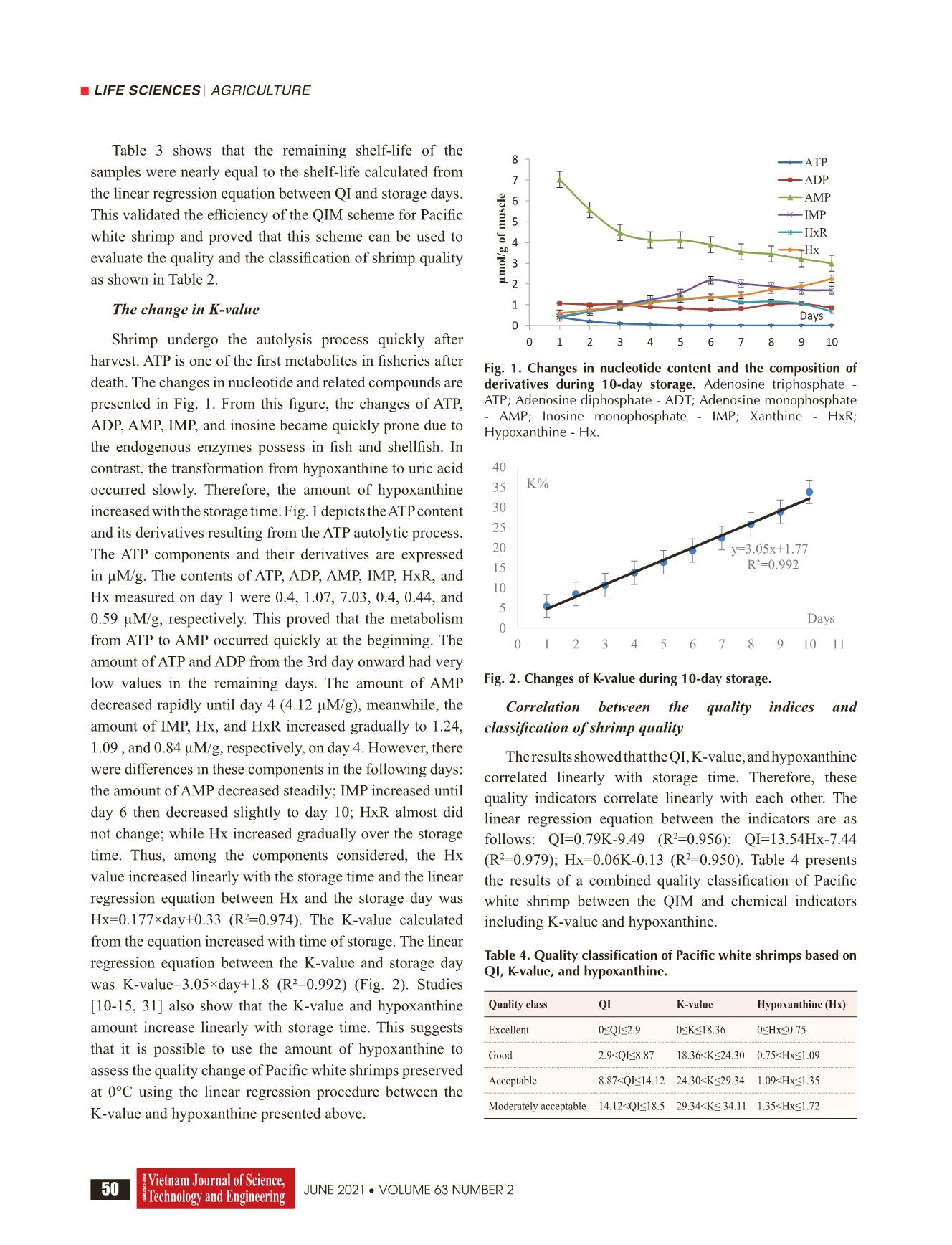
Trang 6
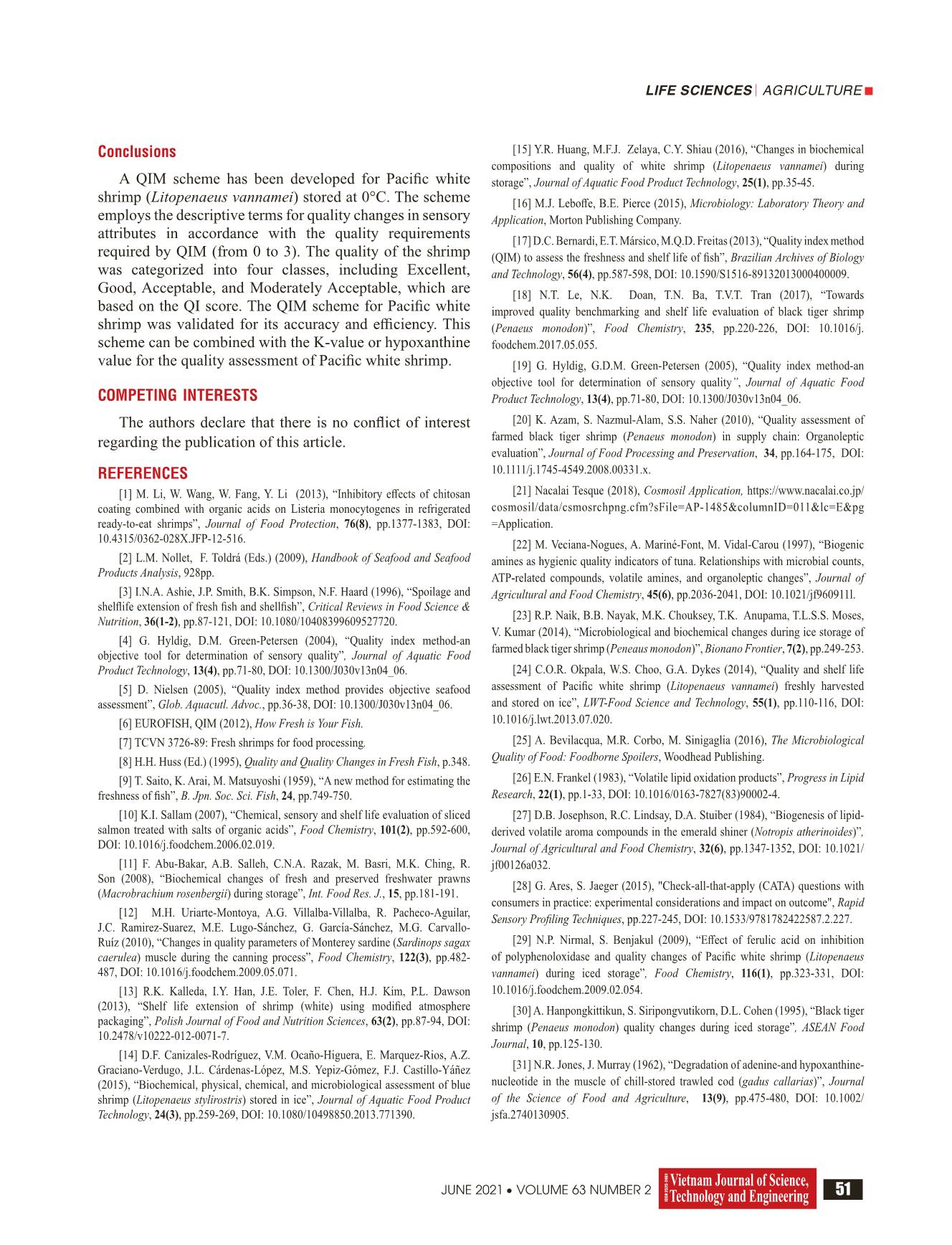
Trang 7
Tóm tắt nội dung tài liệu: The combination of microbiological, biochemical, and quality index methods in quality evaluation of pacific white shrimps (Litopenaeus vannamei) preserved at 0°C
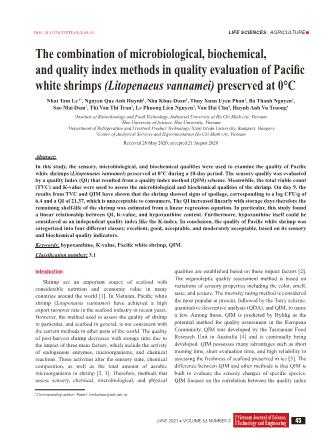
Life ScienceS | Agriculture Vietnam Journal of Science, Technology and Engineering 45June 2021 • Volume 63 number 2 Introduction Shrimp are an important source of seafood with considerable nutrition and economic value in many countries around the world [1]. In Vietnam, Pacific white shrimp (Litopenaeus vannamei) have achieved a high export turnover rate in the seafood industry in recent years. However, the method used to assess the quality of shrimp in particular, and seafood in general, is not consistent with the current methods in other parts of the world. The quality of post-harvest shrimp decreases with storage time due to the impact of three main factors, which include the activity of endogenous enzymes, microorganisms, and chemical reactions. These activities alter the sensory state, chemical composition, as well as the total amount of aerobic microorganisms in shrimp [2, 3]. Therefore, methods that assess sensory, chemical, microbiological, and physical qualities are established based on these impact factors [2]. The organoleptic quality assessment method is based on variations of sensory properties including the color, smell, taste, and texture. The intensity rating method is considered the most popular at present, followed by the Torry scheme, quantitative descriptive analysis (QDA), and QIM, to name a few. Among those, QIM is predicted by Hyldig as the potential method for quality assessment in the European Community. QIM was developed by the Tasmanian Food Research Unit in Australia [4] and is continually being developed. QIM possesses many advantages such as short training time, short evaluation time, and high reliability in assessing the freshness of seafood preserved in ice [5]. The difference between QIM and other methods is that QIM is built to evaluate the sensory changes of specific species. QIM focuses on the correlation between the quality index The combination of microbiological, biochemical, and quality index methods in quality evaluation of pacific white shrimps (Litopenaeus vannamei) preserved at 0°C Nhat Tam Le 1*, Nguyen Que Anh Huynh1, Nhu Khue Doan1, Thuy Xuan Uyen Phan1, Ba Thanh Nguyen1, Sao Mai Dam1, Thi Van Thi Tran2, Le phuong Lien Nguyen3, Van Hai Chu4, Huynh Anh Vu Truong4 1Institute of Biotechnology and Food Technology, Industrial University of Ho Chi Minh city, Vietnam 2Hue University of Science, Hue University, Vietnam 3Department of Refrigeration and Livestock Product Technology, Szent István University, Budapest, Hungary 4Center of Analytical Services and Experimentation Ho Chi Minh city, Vietnam Received 28 May 2020; accepted 21 August 2020 *Corresponding author: Email: lenhattam@iuh.edu.vn Abstract: In this study, the sensory, microbiological, and biochemical qualities were used to examine the quality of Pacific white shrimps (Litopenaeus vannamei) preserved at 0°C during a 10-day period. The sensory quality was evaluated by a quality index (QI) that resulted from a quality index method (QIM) scheme. Meanwhile, the total viable count (TVC) and K-value were used to assess the microbiological and biochemical qualities of the shrimp. On day 9, the results from TVC and QIM have shown that the shrimp showed signs of spoilage, corresponding to a log CFU/g of 6.4 and a QI of 21.37, which is unacceptable to consumers. The QI increased linearly with storage days therefore the remaining shelf-life of the shrimp was estimated from a linear regression equation. In particular, this study found a linear relationship between QI, K-value, and hypoxanthine content. Furthermore, hypoxanthine itself could be considered as an independent quality index like the K-index. In conclusion, the quality of Pacific white shrimp was categorized into four different classes: excellent, good, acceptable, and moderately acceptable, based on its sensory and biochemical quality indicators. Keywords: hypoxanthine, K-value, pacific white shrimp, QIM. Classification number: 3.1 DOI: 10.31276/VJSTE.63(2).45-51 Life ScienceS | Agriculture Vietnam Journal of Science, Technology and Engineering46 June 2021 • Volume 63 number 2 and the storage time expressed via a linear regression equation. Thus, QIM allows an estimation of the remaining shelf-life of seafood. So far, QIM-Eurofish has developed 28 QIM schemes mainly for fish, shrimp, and squid species. However, the QIM scheme for Pacific white shrimp has not yet been developed [6]. In Vietnam, shrimp quality is assessed according to TCVN 3276-89 [7]. This standard is generally applied to all shrimp species and is not an intensity rating method, however, it is a semi-quantitative assessment that describes changes in the properties of shrimp. Therefore, quality results from TCVN 3276-89 do not resemble those obtained by the rating method used in importing countries. This leads to disputes over quality and financial losses for exporting enterprises. After shrimp die, the process of self- decomposition takes place immediately, which is followed by the process of decomposition [8]. This autolysis is caused by endogenous enzymes in the shrimp and results in the release of nucleotides and its derivatives. In 1959, Saito and his colleagues introduced the “K-value”, which is calculated based on nucleotides and their derivatives. The “K-value” has been formulated as an index of freshness in seafood [9]. Unlike quality indicators such as TVB-N, TMA-N, or histamine that are suitable for assessing quality during the decomposition stage, the K-value tends to linearly correlate with storage time [10-15]. This allows researchers to develop a regression equation between the QI and K-value. Therefore, this study aims to develop a complete quality assessment process including the analytical methods measuring the microbiological, biochemical, and sensory changes. The expected findings includ ... heme for Pacific white shrimp and proved that this scheme can be used to evaluate the quality and the classification of shrimp quality as shown in Table 2. The change in K-value Shrimp undergo the autolysis process quickly after harvest. ATP is one of the first metabolites in fisheries after death. The changes in nucleotide and related compounds are presented in Fig. 1. From this figure, the changes of ATP, ADP, AMP, IMP, and inosine became quickly prone due to the endogenous enzymes possess in fish and shellfish. In contrast, the transformation from hypoxanthine to uric acid occurred slowly. Therefore, the amount of hypoxanthine increased with the storage time. Fig. 1 depicts the ATP content and its derivatives resulting from the ATP autolytic process. The ATP components and their derivatives are expressed in µM/g. The contents of ATP, ADP, AMP, IMP, HxR, and Hx measured on day 1 were 0.4, 1.07, 7.03, 0.4, 0.44, and 0.59 µM/g, respectively. This proved that the metabolism from ATP to AMP occurred quickly at the beginning. The amount of ATP and ADP from the 3rd day onward had very low values in the remaining days. The amount of AMP decreased rapidly until day 4 (4.12 µM/g), meanwhile, the amount of IMP, Hx, and HxR increased gradually to 1.24, 1.09 , and 0.84 µM/g, respectively, on day 4. However, there were differences in these components in the following days: the amount of AMP decreased steadily; IMP increased until day 6 then decreased slightly to day 10; HxR almost did not change; while Hx increased gradually over the storage time. Thus, among the components considered, the Hx value increased linearly with the storage time and the linear regression equation between Hx and the storage day was Hx=0.177×day+0.33 (R2=0.974). The K-value calculated from the equation increased with time of storage. The linear regression equation between the K-value and storage day was K-value=3.05×day+1.8 (R²=0.992) (Fig. 2). Studies [10-15, 31] also show that the K-value and hypoxanthine amount increase linearly with storage time. This suggests that it is possible to use the amount of hypoxanthine to assess the quality change of Pacific white shrimps preserved at 0°C using the linear regression procedure between the K-value and hypoxanthine presented above. Fig. 1. Changes in nucleotide content and the composition of derivatives during 10-day storage. Adenosine triphosphate - ATP; Adenosine diphosphate - ADT; Adenosine monophosphate - AmP; Inosine monophosphate - ImP; Xanthine - Hxr; Hypoxanthine - Hx. Fig. 2. Changes of K-value during 10-day storage. Correlation between the quality indices and classification of shrimp quality The results showed that the QI, K-value, and hypoxanthine correlated linearly with storage time. Therefore, these quality indicators correlate linearly with each other. The linear regression equation between the indicators are as follows: QI=0.79K-9.49 (R2=0.956); QI=13.54Hx-7.44 (R2=0.979); Hx=0.06K-0.13 (R2=0.950). Table 4 presents the results of a combined quality classification of Pacific white shrimp between the QIM and chemical indicators including K-value and hypoxanthine. Table 4. Quality classification of Pacific white shrimps based on QI, K-value, and hypoxanthine. Quality class QI K-value Hypoxanthine (Hx) Excellent 0≤QI≤2.9 0≤K≤18.36 0≤Hx≤0.75 Good 2.9<QI≤8.87 18.36<K≤24.30 0.75<Hx≤1.09 Acceptable 8.87<QI≤14.12 24.30<K≤29.34 1.09<Hx≤1.35 Moderately acceptable 14.12<QI≤18.5 29.34<K≤ 34.11 1.35<Hx≤1.72 components in the following days: the amount of AMP decreased steadily; IMP increased until day 6 then decreased slightly to day 10; HxR almost did not change; while Hx increased gradually over the storage time. Thus, among the components considered, the Hx value increased linearly with the storage time and the linear regression equation between Hx and the storage day was Hx = 0.177×day + 0.33 (R2 = 0.974). The K-value calculated from the equation increased with time of storage. The linear regression equation between the K- value and storage day was K-value = 3.05×day + 1.8 (R² = 0.992) (Fig. 2). Studies [10-15, 31] also show that the K-value and hypoxanthine amount increase linearly with storage time. This suggests that it is possible to use the amount of hypoxanthine to assess the quality change of Pacific white shrimps preserved at 0°C using the linear regression procedure between the K-value and hypoxanthine presented above. Fig. 1. Changes in nucleotide content and the composition of derivatives during 10-day storage. (Adenosine triphosphate - ATP; Adenosine diphosphate - ADT; Adenosine monophosphate - AMP; Inosine monophosphate - IMP; Xanthine - HxR; Hypoxanthine - Hx). 0 1 2 3 4 5 6 7 8 0 1 2 3 4 5 6 7 8 9 10 µ m ol /g o f m us cl e Days ATP ADP AMP IMP HxR Hx Fig. 2. Changes of K-value during 10-day storage. Correlation between the quality indices and classification of shrimp quality The results showed that the QI, K-value, and hypoxanthine correlated linearly with storage time. Therefore, these quality indica ors correlate linearly with each other. The linear regression equation between the indicators are as follows: QI = 0.79K - 9.49 (R2 = 0.956); QI = 13.54Hx - 7.44 (R2=0.979); Hx = 0.06K - 0.13 (R2 = 0.950). Table 4 presents the results of a combined quality classification of Pacific white shrimp between the QIM and chemical indicators including K-valu and hypoxanthine. Table 4. Quality classification of white pacific shrimps based on QI, K-value, and hypoxanthine. Quality class QI K-value Hypoxanthine (Hx) Excellent 0≤QI≤2.9 0≤K≤18.36 0 ≤Hx≤ 0.75 Good 2.9<QI≤8.87 18.36<K≤24.30 0.75<Hx≤1.09 Acceptable 8.87<QI≤14.12 24.30<K≤29.34 1.09<Hx≤1.35 Moderately Acceptable 14.12<QI≤18.5 29.34<K≤ 34.11 1.35<Hx≤1.72 Conclusions A QIM scheme has been developed for Pacific white shrimp (Litopenaeus vannamei) stored at 0°C. The scheme employs the descriptive terms for quality changes in sensory attributes in accordance with the quality requirements required by QIM (from 0 to 3). The quality of the shrimp was categorized into four classes, including Excellent, Good, Acceptable, and Moderately Acceptable, which are based on the QI score. The QIM scheme for Pacific white y=3.05x+1.77 R²=0.992 0 5 10 15 20 25 30 35 40 0 1 2 3 4 5 6 7 8 9 10 11 K % Days Life ScienceS | Agriculture Vietnam Journal of Science, Technology and Engineering 51June 2021 • Volume 63 number 2 Conclusions A QIM scheme has been developed for Pacific white shrimp (Litopenaeus vannamei) stored at 0°C. The scheme employs the descriptive terms for quality changes in sensory attributes in accordance with the quality requirements required by QIM (from 0 to 3). The quality of the shrimp was categorized into four classes, including Excellent, Good, Acceptable, and Moderately Acceptable, which are based on the QI score. The QIM scheme for Pacific white shrimp was validated for its accuracy and efficiency. This scheme can be combined with the K-value or hypoxanthine value for the quality assessment of Pacific white shrimp. COMPETING INTERESTS The authors declare that there is no conflict of interest regarding the publication of this article. REFERENCES [1] M. Li, W. Wang, W. Fang, Y. Li (2013), “Inhibitory effects of chitosan coating combined with organic acids on Listeria monocytogenes in refrigerated ready-to-eat shrimps”, Journal of Food Protection, 76(8), pp.1377-1383, DOI: 10.4315/0362-028X.JFP-12-516. [2] L.M. Nollet, F. Toldrá (Eds.) (2009), Handbook of Seafood and Seafood Products Analysis, 928pp. [3] I.N.A. Ashie, J.P. Smith, B.K. Simpson, N.F. Haard (1996), “Spoilage and shelflife extension of fresh fish and shellfish”, Critical Reviews in Food Science & Nutrition, 36(1-2), pp.87-121, DOI: 10.1080/10408399609527720. [4] G. Hyldig, D.M. Green-Petersen (2004), “Quality index method-an objective tool for determination of sensory quality”, Journal of Aquatic Food Product Technology, 13(4), pp.71-80, DOI: 10.1300/J030v13n04_06. [5] D. Nielsen (2005), “Quality index method provides objective seafood assessment”, Glob. Aquacutl. Advoc., pp.36-38, DOI: 10.1300/J030v13n04_06. [6] EUROFISH, QIM (2012), How Fresh is Your Fish. [7] TCVN 3726-89: Fresh shrimps for food processing. [8] H.H. Huss (Ed.) (1995), Quality and Quality Changes in Fresh Fish, p.348. [9] T. Saito, K. Arai, M. Matsuyoshi (1959), “A new method for estimating the freshness of fish”, B. Jpn. Soc. Sci. Fish, 24, pp.749-750. [10] K.I. Sallam (2007), “Chemical, sensory and shelf life evaluation of sliced salmon treated with salts of organic acids”, Food Chemistry, 101(2), pp.592-600, DOI: 10.1016/j.foodchem.2006.02.019. [11] F. Abu-Bakar, A.B. Salleh, C.N.A. Razak, M. Basri, M.K. Ching, R. Son (2008), “Biochemical changes of fresh and preserved freshwater prawns (Macrobrachium rosenbergii) during storage”, Int. Food Res. J., 15, pp.181-191. [12] M.H. Uriarte-Montoya, A.G. Villalba-Villalba, R. Pacheco-Aguilar, J.C. Ramirez-Suarez, M.E. Lugo-Sánchez, G. García-Sánchez, M.G. Carvallo- Ruíz (2010), “Changes in quality parameters of Monterey sardine (Sardinops sagax caerulea) muscle during the canning process”, Food Chemistry, 122(3), pp.482- 487, DOI: 10.1016/j.foodchem.2009.05.071. [13] R.K. Kalleda, I.Y. Han, J.E. Toler, F. Chen, H.J. Kim, P.L. Dawson (2013), “Shelf life extension of shrimp (white) using modified atmosphere packaging”, Polish Journal of Food and Nutrition Sciences, 63(2), pp.87-94, DOI: 10.2478/v10222-012-0071-7. [14] D.F. Canizales-Rodríguez, V.M. Ocaño-Higuera, E. Marquez-Rios, A.Z. Graciano-Verdugo, J.L. Cárdenas-López, M.S. Yepiz-Gómez, F.J. Castillo-Yáñez (2015), “Biochemical, physical, chemical, and microbiological assessment of blue shrimp (Litopenaeus stylirostris) stored in ice”, Journal of Aquatic Food Product Technology, 24(3), pp.259-269, DOI: 10.1080/10498850.2013.771390. [15] Y.R. Huang, M.F.J. Zelaya, C.Y. Shiau (2016), “Changes in biochemical compositions and quality of white shrimp (Litopenaeus vannamei) during storage”, Journal of Aquatic Food Product Technology, 25(1), pp.35-45. [16] M.J. Leboffe, B.E. Pierce (2015), Microbiology: Laboratory Theory and Application, Morton Publishing Company. [17] D.C. Bernardi, E.T. Mársico, M.Q.D. Freitas (2013), “Quality index method (QIM) to assess the freshness and shelf life of fish”, Brazilian Archives of Biology and Technology, 56(4), pp.587-598, DOI: 10.1590/S1516-89132013000400009. [18] N.T. Le, N.K. Doan, T.N. Ba, T.V.T. Tran (2017), “Towards improved quality benchmarking and shelf life evaluation of black tiger shrimp (Penaeus monodon)”, Food Chemistry, 235, pp.220-226, DOI: 10.1016/j. foodchem.2017.05.055. [19] G. Hyldig, G.D.M. Green-Petersen (2005), “Quality index method-an objective tool for determination of sensory quality”, Journal of Aquatic Food Product Technology, 13(4), pp.71-80, DOI: 10.1300/J030v13n04_06. [20] K. Azam, S. Nazmul-Alam, S.S. Naher (2010), “Quality assessment of farmed black tiger shrimp (Penaeus monodon) in supply chain: Organoleptic evaluation”, Journal of Food Processing and Preservation, 34, pp.164-175, DOI: 10.1111/j.1745-4549.2008.00331.x. [21] Nacalai Tesque (2018), Cosmosil Application, https://www.nacalai.co.jp/ cosmosil/data/csmosrchpng.cfm?sFile=AP-1485&columnID=011&lc=E&pg =Application. [22] M. Veciana-Nogues, A. Mariné-Font, M. Vidal-Carou (1997), “Biogenic amines as hygienic quality indicators of tuna. Relationships with microbial counts, ATP-related compounds, volatile amines, and organoleptic changes”, Journal of Agricultural and Food Chemistry, 45(6), pp.2036-2041, DOI: 10.1021/jf960911l. [23] R.P. Naik, B.B. Nayak, M.K. Chouksey, T.K. Anupama, T.L.S.S. Moses, V. Kumar (2014), “Microbiological and biochemical changes during ice storage of farmed black tiger shrimp (Peneaus monodon)”, Bionano Frontier, 7(2), pp.249-253. [24] C.O.R. Okpala, W.S. Choo, G.A. Dykes (2014), “Quality and shelf life assessment of Pacific white shrimp (Litopenaeus vannamei) freshly harvested and stored on ice”, LWT-Food Science and Technology, 55(1), pp.110-116, DOI: 10.1016/j.lwt.2013.07.020. [25] A. Bevilacqua, M.R. Corbo, M. Sinigaglia (2016), The Microbiological Quality of Food: Foodborne Spoilers, Woodhead Publishing. [26] E.N. Frankel (1983), “Volatile lipid oxidation products”, Progress in Lipid Research, 22(1), pp.1-33, DOI: 10.1016/0163-7827(83)90002-4. [27] D.B. Josephson, R.C. Lindsay, D.A. Stuiber (1984), “Biogenesis of lipid- derived volatile aroma compounds in the emerald shiner (Notropis atherinoides)”, Journal of Agricultural and Food Chemistry, 32(6), pp.1347-1352, DOI: 10.1021/ jf00126a032. [28] G. Ares, S. Jaeger (2015), "Check-all-that-apply (CATA) questions with consumers in practice: experimental considerations and impact on outcome", Rapid Sensory Profiling Techniques, pp.227-245, DOI: 10.1533/9781782422587.2.227. [29] N.P. Nirmal, S. Benjakul (2009), “Effect of ferulic acid on inhibition of polyphenoloxidase and quality changes of Pacific white shrimp (Litopenaeus vannamei) during iced storage”, Food Chemistry, 116(1), pp.323-331, DOI: 10.1016/j.foodchem.2009.02.054. [30] A. Hanpongkittikun, S. Siripongvutikorn, D.L. Cohen (1995), “Black tiger shrimp (Penaeus monodon) quality changes during iced storage”, ASEAN Food Journal, 10, pp.125-130. [31] N.R. Jones, J. Murray (1962), “Degradation of adenine‐and hypoxanthine- nucleotide in the muscle of chill-stored trawled cod (gadus callarias)”, Journal of the Science of Food and Agriculture, 13(9), pp.475-480, DOI: 10.1002/ jsfa.2740130905.
File đính kèm:
 the_combination_of_microbiological_biochemical_and_quality_i.pdf
the_combination_of_microbiological_biochemical_and_quality_i.pdf

